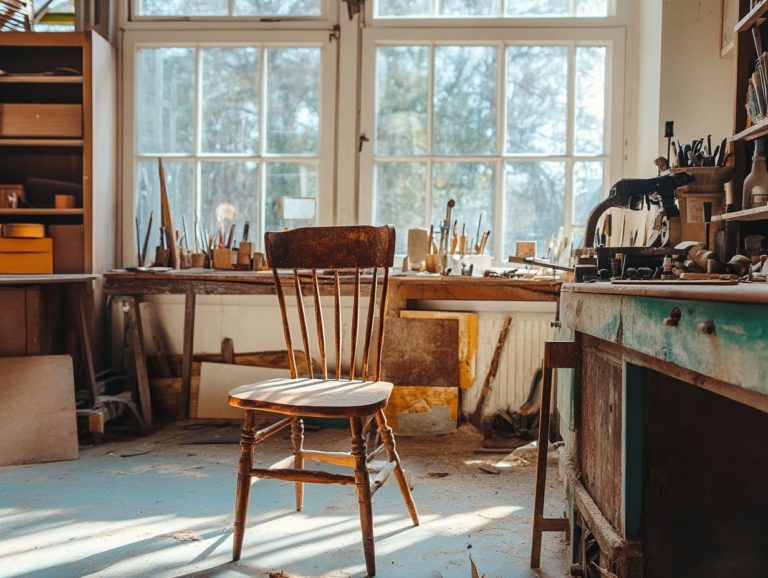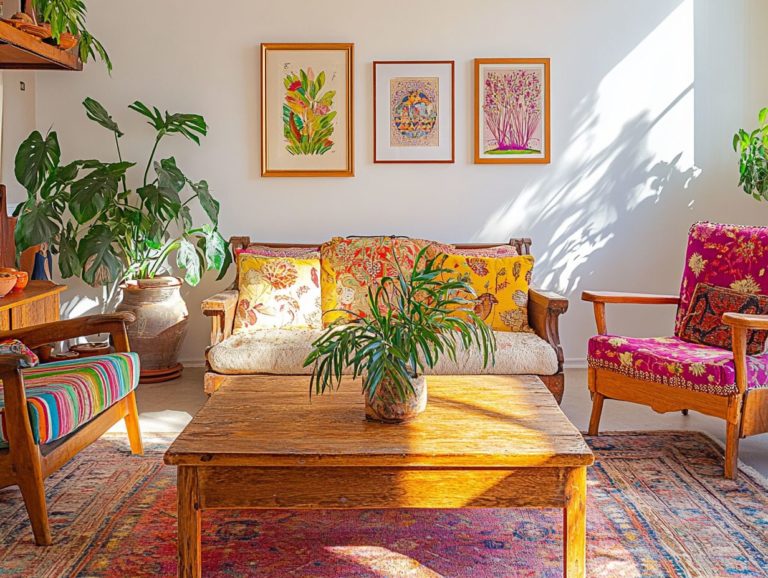Transforming Old Furniture: Quick DIY Tips
Ready to turn that tired old furniture into something amazing? Furniture transformation is your opportunity to breathe new life into tired items while showcasing your unique style.
This article delves into the myriad benefits of DIY furniture transformation, from significant cost savings to crafting personalized masterpieces. You ll learn how to select the right furniture, gather essential tools, and apply various techniques to rejuvenate dressers, side tables, and chairs.
Uncover tips for adding those perfect finishing touches and maintaining your newly transformed treasures. Prepare to unleash your creativity and turn the ordinary into something extraordinary!
Contents
- Key Takeaways:
- Benefits of DIY Furniture Transformation
- Choosing the Right Furniture for Transformation
- Preparing for Furniture Transformation
- DIY Techniques for Furniture Transformation
- Transforming Specific Types of Furniture
- Final Touches and Maintenance
- Frequently Asked Questions
- What are some quick DIY tips for transforming old furniture?
- What tools do I need for a successful furniture transformation?
- Can I transform any type of furniture?
- Do I need to be experienced in DIY projects to transform old furniture?
- How can I ensure a successful furniture transformation?
- Can I use environmentally-friendly products for my furniture transformation?
Key Takeaways:
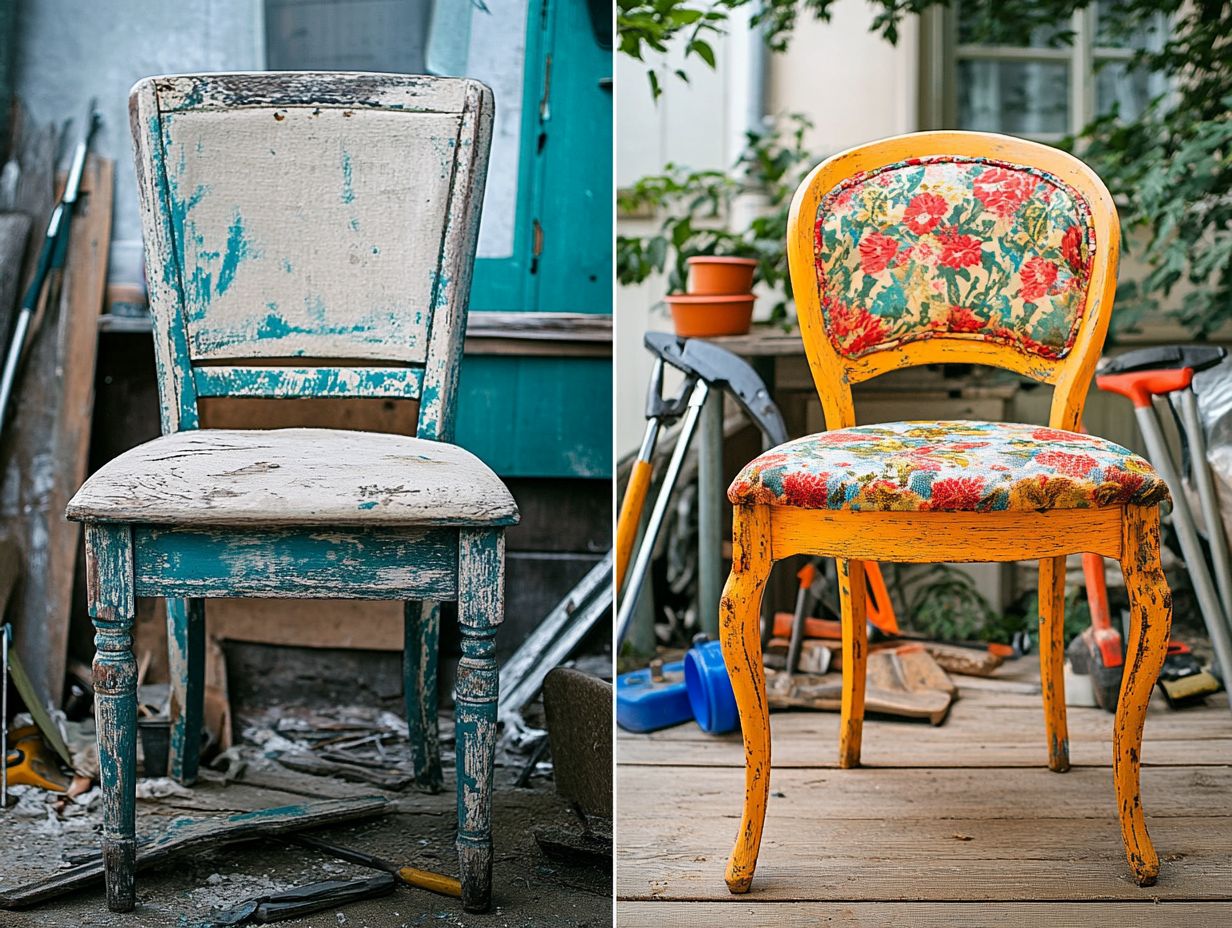
- DIY furniture transformation is a cost-effective and personalized way to revamp old furniture.
- Choosing the right materials and techniques for different furniture types is crucial for successful transformation.
- Proper preparation and essential tools are key to achieving a professional and long-lasting finish.
What is Furniture Transformation?
Furniture transformation is an innovative journey. It breathes new life into old pieces using various techniques and creative flair. It allows you to modernize your space while embracing a sustainable lifestyle.
This practice ranges from simple makeovers and upcycling vintage finds to comprehensive restorations that revitalize vintage dressers, side tables, and other cherished items. You might find yourself browsing thrift stores and garage sales, hunting for hidden gems just waiting for a mini transformation. This ensures that unique styles and stories continue to thrive in today’s home decor.
These transformations go beyond mere aesthetics; they show a commitment to being eco-friendly by reducing waste and promoting the reuse of materials. Techniques like chalk painting, which uses matte paint that is easily distressed, or reupholstering, give personality and flair to your spaces, showcasing your creativity and individuality. For more insights, check out transforming vintage finds with furniture refinishing methods, ensuring your pieces will stand out.
The rising trend of statement pieces think a refurbished dining table or a colorful accent chair can dramatically enhance the ambiance of your home, making each room feel more inviting and distinct.
By engaging in furniture transformation, you elevate your home with custom designs and play a part in nurturing a more sustainable planet by giving new life to forgotten treasures. This ensures your home reflects cozy decor that tells a story.
Benefits of DIY Furniture Transformation
Engaging in DIY furniture transformation offers a wealth of benefits, including budget-friendly solutions to refresh your home decor and the chance to craft personalized pieces that truly reflect your style.
As you dive into various furniture projects, you not only save money but also experience a sense of fulfillment from your creative endeavors while championing sustainability through upcycling. This helps create a more vibrant home decor.
Additionally, these DIY projects enable you to add unique decorative elements and textures, elevating your home improvement efforts and creating warm, inviting spaces throughout your home.
Cost-Effective and Personalized Furniture
Transforming old furniture into personalized pieces is not just a delightful DIY project; it s a savvy way to furnish your home while showcasing your unique style. By scouring thrift stores or garage sales, you can uncover hidden gems and create stunning upcycled solutions that suit your individual taste without stretching your budget.
Imagine this: a simple coat of paint can metamorphose a tired dresser into a vibrant statement piece. Reupholstering an outdated chair with chic fabric? That’s like giving it a new lease on life. These endeavors not only save you money but also serve as a canvas for your creativity, allowing you to design furniture that tells your story and harmonizes beautifully with your living space. For those interested in restoring vintage pieces, check out these DIY staining and finishing tips.
Whether you choose to distress an old table for that rustic charm or add stenciled designs for a modern flair, the possibilities are as limitless as your imagination. And the satisfaction that comes from crafting something uniquely yours? That’s truly priceless.
Choosing the Right Furniture for Transformation
Selecting the right furniture is key to achieving stunning results. Pinpoint old pieces with character that can embrace new life in unique styles.
You can draw inspiration from past designs, trends, and your personal tastes. This helps you choose items that resonate with your desired aesthetic while ensuring they re perfect candidates for your projects. Whether you re considering a vintage-style dresser, a classic antique washstand, or a simple side table, your choice of furniture kicks off an exciting transformation journey.
Materials and Techniques for Different Types of Furniture
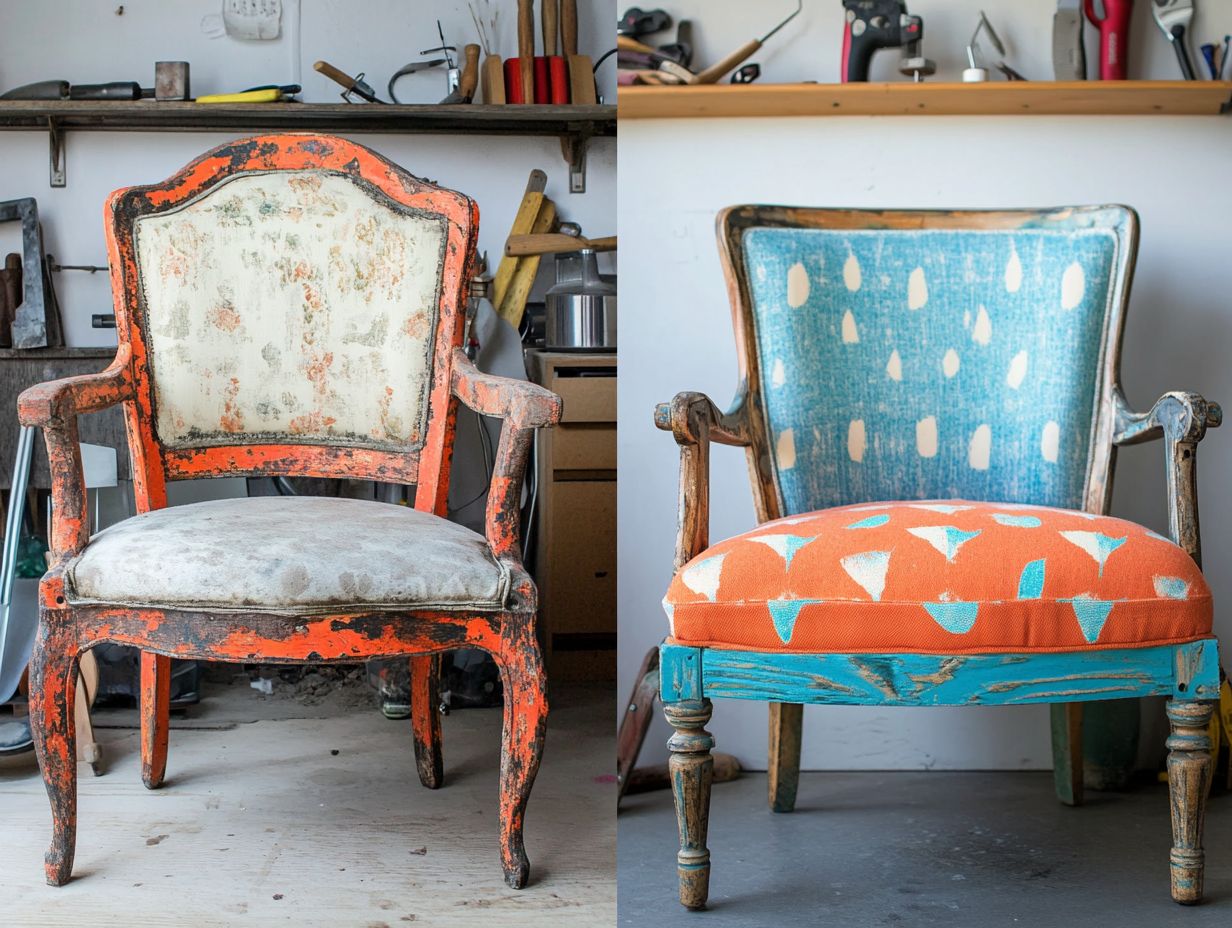
Know the right materials and techniques for your furniture. Each piece requires specific approaches, such as painting, refinishing, or upcycling. Popular materials like chalk paint and milk paint offer versatile options, allowing you to express your creativity while enhancing visual appeal.
Utilizing spray paint can provide a smooth finish for metal or intricate woodwork. At the same time, distressing techniques can add rustic charm to your existing items. Each method has advantages and challenges; for example, chalk paint is user-friendly and offers a lovely matte finish, but it might need sealing for added durability. In contrast, refinishing often involves stripping away old finishes but can lead to stunning, long-lasting results.
By exploring these elements, you empower yourself to creatively revitalize your furnishings. This ensures each project reflects your unique style while meeting practical needs, such as storage solutions for a more organized home.
Preparing for Furniture Transformation
Preparation is a pivotal step in your transformation journey. Equipping yourself with the right tools and supplies is essential for a seamless and efficient process, significantly enhancing the potential for stunning results.
Before you immerse yourself in your DIY furniture projects, gather the essentials brushes, sandpaper, and the paints or stains that will elevate your pieces. For creativity and direction, consider exploring upcycling vintage furniture. Prepare to invest time and effort into your transformations; hard work goes a long way toward achieving your vision.
Essential Tools and Supplies
Having the right tools is essential for your furniture transformation journey. This empowers you to execute your vision with precision and efficiency. From basic items like paintbrushes and sandpaper to specialized tools for painting and refinishing, the right equipment is crucial for mastering various techniques and achieving a professional-looking finish.
Start with high-quality paintbrushes and rollers tailored to different surfaces; this ensures smoother application and even coverage. Sandpaper, available in various grits, is critical for prepping surfaces, allowing paint to adhere better and providing a refined finish. Tools like a staple gun and clamps are handy for upholstery projects, while a paint sprayer can elevate your transformation for larger pieces.
Don t forget essential safety gear, such as masks and goggles. Protecting yourself against dirt and fumes is key, allowing you to work confidently and effectively without compromising your health.
DIY Techniques for Furniture Transformation
Mastering various DIY techniques is essential for successfully transforming your furniture. This knowledge empowers you to choose the best methods for painting, staining, or refinishing each piece, tailored to its material and the aesthetic you envision.
Using techniques like milk paint or chalk paint can dramatically change the character of your furniture. These techniques yield stunning results that infuse new life into cherished items, making them unique pieces.
Painting, Staining, and Refinishing
Painting, staining, and refinishing are essential for transforming your furniture. They allow you to dramatically change the look and feel of your pieces.
Choose between a bold chalk paint finish or a subtle wood stain. Understanding each method is key to achieving your desired style and ensuring lasting results.
These techniques enhance the aesthetic appeal and protect your furniture. For instance, chalk paint offers a matte finish that complements rustic decor beautifully.
A glossy enamel can elevate a modern piece with sophistication. Staining reveals the natural grain of the wood, creating an organic vibe appreciated by nature lovers.
Refinishing restores historical pieces or gives them a contemporary twist. You can incorporate techniques like adding overlays or creating a worn look.
Mastering these techniques opens a world of possibilities. You can experiment with diverse color palettes and finishes that will truly transform any space.
Transforming Specific Types of Furniture
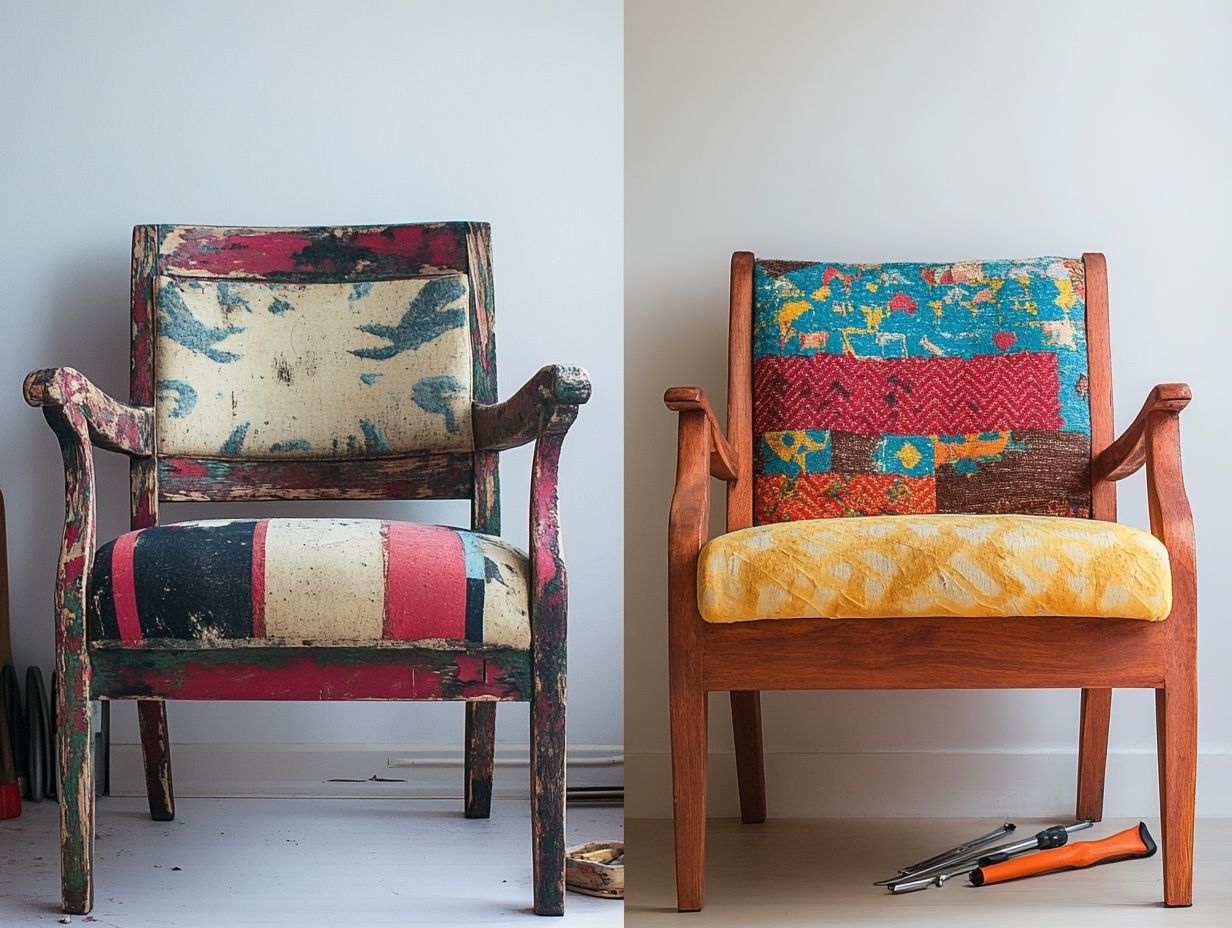
Transforming furniture like dressers, chairs, and tables demands a tailored approach. Understanding each piece’s distinct characteristics lets you create beautiful designs.
Embrace the details, and watch your DIY projects come to life with beauty and purpose.
Tips for Dressers, Chairs, and Tables
When transforming dressers, chairs, and tables, keep essential tips in mind. Consider each piece’s functionality while enhancing its aesthetics.
Update drawer pulls on dressers and apply chic paint techniques on chairs and tables. These small changes can elevate your home decor.
Assess your space and choose colors and materials that harmonize with your decor. A vintage dresser can shine with a bold new coat of paint, becoming a standout piece.
Sleek modern chairs benefit from custom upholstery that matches your style. Multifunctional tables with hidden storage maximize space while maintaining elegance.
Focus on both practicality and design to create a unique furniture collection. This collection will reflect your personal taste and enhance your rooms’ functionality.
Final Touches and Maintenance
Adding final touches and implementing maintenance practices are crucial. This ensures that your finished furniture captivates the eye and stands the test of time.
Stylish hardware and protective finishes elevate your piece’s beauty while safeguarding it from wear and tear. This solidifies the value of your DIY efforts.
Adding Hardware and Protecting the Finished Product
Adding hardware to your transformed furniture not only boosts its functionality but also elevates the overall look. This makes each piece truly unique and personal to you.
Protecting the finished product with the right coatings or waxes ensures that your hard work stands the test of time. This allows you to relish the beauty of your furniture transformations for years to come.
In terms of hardware options, you ll find a delightful array from decorative knobs and handles to intricate drawer slides that enhance usability. Techniques like drilling precise holes for hardware installation or opting for adhesive strips for easier attachment can truly transform your project.
Finishes such as polyurethane or furniture oils act as protective layers, keeping the surface safe while enhancing the wood grains’ visual depth.
Exploring these details strengthens the lasting quality of your transformations and grants you the chance to express yourself. This allows you to infuse your personal style into every corner of your living spaces.
Frequently Asked Questions
What are some quick DIY tips for transforming old furniture?
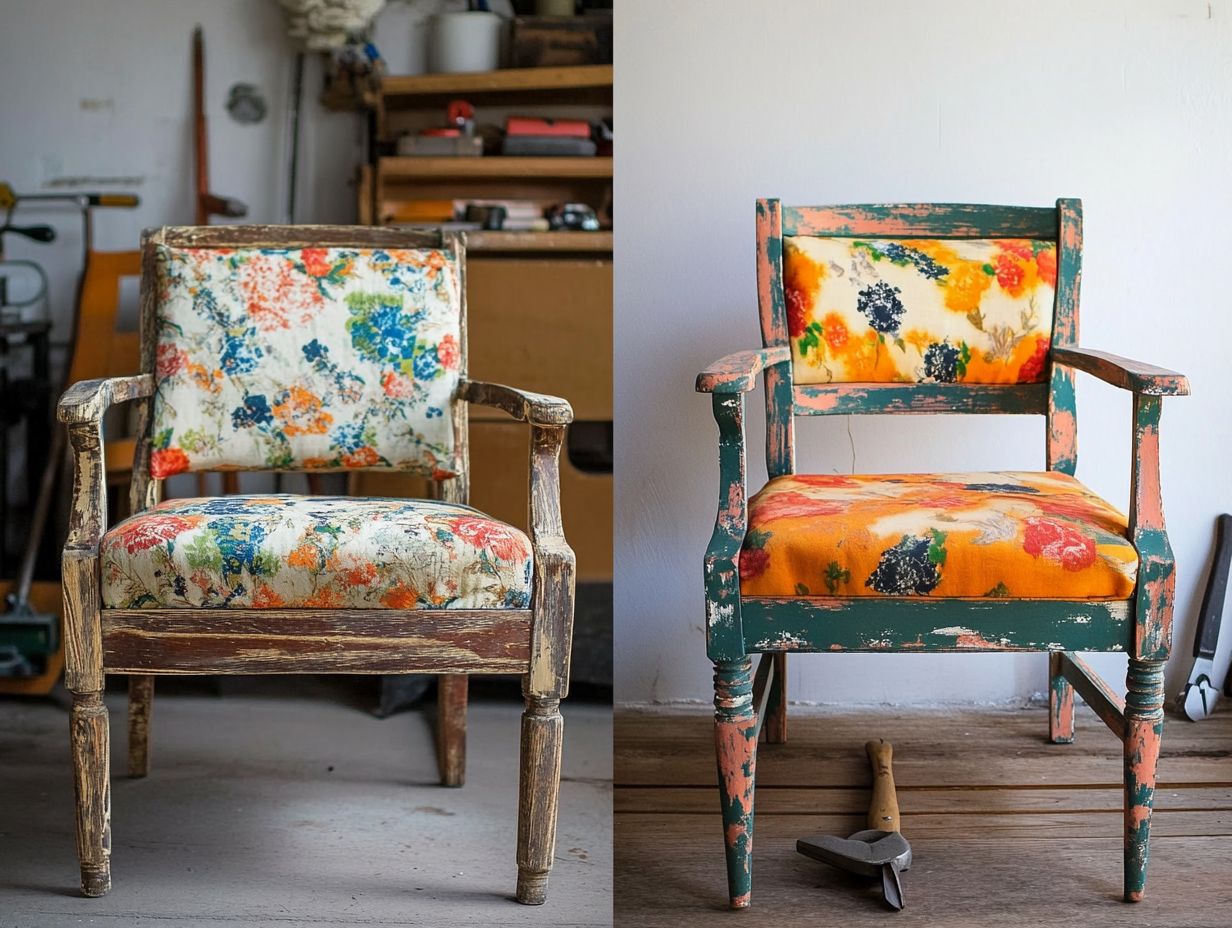
- Sanding and repainting or staining the furniture is an easy and effective way to transform its look.
- Use wallpaper or contact paper to cover old drawers or cabinets for a unique and budget-friendly update.
- Replace old hardware, such as handles or knobs, to give the furniture a fresh new look.
- Add a pop of color by painting just the legs or trim of the furniture instead of the entire piece.
- Create patterns or designs on the furniture using stencils for a personalized touch.
- Reupholster old chairs or couches with new fabric to completely transform their appearance.
What tools do I need for a successful furniture transformation?
To transform old furniture, you will need basic tools such as a sander (a tool for smoothing surfaces), paintbrushes, and a drill for replacing hardware. Additional tools may include a nail gun, staple gun (a tool used to attach fabric), or sewing machine depending on the project.
Can I transform any type of furniture?
You can absolutely transform any type of furniture, including wood, metal, and upholstered pieces. However, keep in mind that certain materials may require different techniques or products for a successful transformation.
Do I need to be experienced in DIY projects to transform old furniture?
No, you do not need to be experienced in DIY projects to transform old furniture. With some research and basic tools, anyone can successfully give old furniture a new life.
How can I ensure a successful furniture transformation?
Before starting your project, it is important to prepare the furniture properly by cleaning and sanding it. Choose the right products for your furniture type and have a clear vision of the end result. Take your time during the transformation process.
Can I use environmentally-friendly products for my furniture transformation?
Yes, many environmentally-friendly paint and stain options are available for furniture transformation. You can also repurpose and upcycle old materials, such as sheets or curtains, instead of buying new ones. This not only reduces waste but also adds a unique touch to your furniture transformation.



